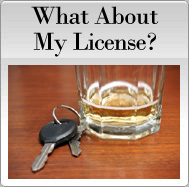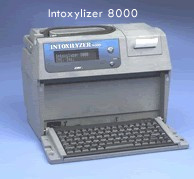
|
Our web page 50 Ways to BEAT a DUI has examples of cases and ways in which a Breath Test can be beaten. It takes a Qualified DUI Firm to properly challenge Breath Test results and we do it on a regular basis. In fact, we have an attorney that is certified in the operation of the same exact Intoxilyzer 8000 breath testing machine which is in use throughout the State of Florida today. To beat it you have to understand it! |
||||||||||||||||||
Many people think that breathalyzers read your blood alcohol content when, in fact, they actually estimate your BAC levels. A breathalyzer attempts to convert your breath alcohol content to BAC by measuring blood alcohol in your breath from the lungs. While a reading suggests more validity, an estimation is what it really is: an educated guess. People are shocked to learn that the Breathalyzer, or the Intoxilyzer 8000 that is used in Florida, has nothing to do with blood alcohol levels. The Intoxilyzer only measures breath alcohol levels. In fact, the Intoxilyzer doesn’t even use its findings to make a calculation or true conversion from breath to blood alcohol, it ESTIMATES! Since the Intoxilyzer estimates BAC, their results may be open to interpretation. Consider how the Intoxilyzer does “convert” breath alcohol content to blood alcohol content. In order to make this “conversion,” the Intoxilyzer assumes a standard ratio of 2100:1 between BAC and breath alcohol content. This ratio assumes that the man or woman being tested is an "average person" in terms of weight, health and other factors relating to his or her age group. It has been shown that this ratio can vary anywhere from 1400:1 to 2800:1 within individuals. In other words, a breath test result of 0.08% may actually vary from 0.5% (under the legal limit) to 0.11% (above the legal limit)!
To believe that the Intoxilyzer is a valid method of determining your BAC, or Blood Alcohol Content, you must first accept the notion that there is a direct relationship between the amount of alcohol in a person’s breath and the amount of alcohol in their blood. The Intoxilyzer 8000 is calibrated to assume this ratio is 2100 to 1 for everyone being tested. The manufacturer of the machine assumes that:
The problem with this method of calibrating the Intoxilyzer 8000 in this manner is that experts all agree that the 2100 to 1 breath to blood ratio is only an average. Bottom line, not everyone has this magical 2100 to 1 ratio. For example, if a person has a ratio lower than 2100 to 1, they will produce an Intoxilyzer result that will be artificially high. If a person has a breath to blood ratio higher than 2100 to 1, they will produce an Intoxilyzer result that will be artificially lower. To date, the company that manufactures the Intoxilyzer, (CMI Corp.,) has yet to invent a method that would calculate the driver’s true ratio and then make the appropriate correction for a more accurate breath test result. Consider the following excerpt from just one study a well known Psychiatric publishing, “In the United States breath alcohol tests are calibrated with the amount of alcohol (in grams) in 210 liters in breath, presumed to be equal to the amount of alcohol in 100 milliliters of blood—a blood-breath (to alcohol) ratio of 2,100:1. In practice, the blood-breath ratio is highly variable, with reported values ranging from 1,981:1 to 2,833:1.” Psychiatric Serv 57:34-36, January 2006, Glenn W. Currier, M.D., M.P.H., Adam J. Trenton, B.A. and Patrick G. Walsh, B.S.
This study found the blood-breath ratio to be highly variable! Scientific studies and evidence such as this can help demonstrate the possible inaccuracy in your breath sample, but also consider how inherent error , acceptable range , and the calibration range can also bring doubt upon your results!
As you can see, there is a very different standard of alcohol concentration in the measurement of breath versus blood. Does that mean the Intoxilyzer machine requires you to produce a breath sample sufficient to fill 210 liters? No, to the contrary you only have to fill a sample chamber big enough to hold 80 milliliters of air. But what it does mean, is that because of your inability to produce a sample 210 liters in size, the machine has a huge task to perform. For instance, in order to produce a .08 reading on the Intoxilyzer, the machine is forced to detect less than one millionth of one fluid ounce of alcohol in your breath sample! That amount is smaller than what would fit on the head of a pin. Given this minute size, wouldn’t you think that checking the machine’s obvious critical calibration criteria before having a driver submit to the test would be imperative to verifying the accuracy of the results? Many people may think that they can have a few drinks and still be able to legally drive. This notion is not always true as BAC can vary within people based on many factors. For example, if you are below the average weight of your age group and haven't eaten all day, a couple of drinks may be enough to push you to 0.08%.
Well, scientists seem to think so! Scientists universally recognize an inherent error in breath analysis, generally of plus or minus .01% in the reading. That means that if everything is working perfectly, which is unlikely, a .10% breathalyzer test result can be anywhere from .09% to .11%. This has been acknowledged by courts across the country (see, for example, People v. Campos, 138 Cal.Rptr. 366 ( California) and Haynes v. Department of Public Safety, 865 P.2d 753 ( Alaska); in State v. Boehmer, 613 P.2d 916 ( Hawaii), the courts have recognized an even larger .0165% inherent error). Taking the .01% variance in the reading, what do we have? Well, with a .08 reading it would be an astonishing +/- 12.5% either direction! Or, put another way, anywhere within a 25% margin of error. So, will a jury be convinced if you have a breath test result of .09, that it is accurate? Does that sound like guilt proven beyond a reasonable doubt? Keep reading, there’s more!
Most states have standards for breath testing. Although some states only provide for a single breath test, most require that two breath tests be given — like Florida. But what if the two tests are outside of the acceptable range? Well, the officer simply keeps testing! That’s right! If the tests fall outside of the given range (+/- .02 reading), there must be a third test. If the tests results are .15, .10 and .12, for example, the test would be a valid. That’s as much as a 50% accuracy range!
An “ inherent error” of +/- .01% in the BAC reading, which could reasonably amount to a 25% range of accuracy in a .08 case; An “ acceptable range” of +/- .02 in the BAC reading, which could reasonably amount to a 40% range of accuracy in a .08 case; And yes, there’s even MORE! The calibration tests performed by the breath test maintenance operator at the agency also has an acceptable “calibration range” of .005% (on a .08 test which must be between .075 and .085), which could reasonably amount to a 12.5% range (.005/.08 X2) of accuracy in a .08 case! Now, taking all this into consideration, does that sound like guilt proven beyond a reasonable doubt? Arguments like these alone can bring significant doubt as to whether or not a breath test is accurate, especially on a reading of .12 or below! But, even if the reading is higher, this argument coupled with others can bring doubt to a juror’s mind as to the reliability and accuracy of the testing procedures and the machine itself!
There are numerous ways in which a Qualified DUI Firm may be able to get your Breath Test suppressed from evidence. You can refer to our Recent Court Victories or 50 Ways to BEAT a DUI to see that just because you have a reading over the legal limit does not necessarily mean that you will be convicted of DUI. For example, if the initial stop of your vehicle was unlawful or your arrest was unlawful, then the breath test would be suppressed. However, even if your stop and arrest were valid, you can still challenge the breath test results in many ways! Some common things to look at include the following:
Other issues that can affect the accuracy of a breath these are:
Assuming that the breathalyzer made an accurate estimation of BAC, some people may be of the opinion that they can not be convicted of DUI if the breath test result is below 0.08%. This is not always true. You may still be charged and later convicted of DUI if you fail field sobriety tests in spite of your breath test result. And if you're under the age of 21, merely having any alcohol on your breath may be enough for a DUI charge and conviction. All 50 states have strict zero tolerance policies which make it illegal for underage drinkers to operate a motor vehicle with a BAC at 0.02 or even lower.
Was the Intoxilyzer machine used in your case properly registered and approved for use by FDLE? Florida Administrative Code 11D-8.003(2) requires that every Intoxilyzer machine used for law enforcement evidentiary purposes in the State of Florida be registered and approved by FDLE. In order to demonstrate compliance with this provision, the Prosecutor must produce a valid FDLE Registration Certificate corresponding to the specific machine used in your case. Can the State produce proper documentation to show that an annual calibration check was performed on the Intoxilyzer machine used in your case? Florida Administrative Code 11D-8.004(3) requires that all evidential breath testing machines be inspected by a Regional Alcohol Breath testing Inspector employed by the Florida Department of Law Enforcement once each calendar year. During FDLE’s annual calibration check, did the Department Inspector properly test the range of the Intoxilyzer’s accuracy? Florida Administrative Code 11D-8.004(2) requires a minimum calibration testing by FDLE of ten tests, at each of three known alcohol concentration levels. Did the calibration checks performed by both the Agency Inspector and the FDLE Department Inspector reveal test results that fell outside of permitted deviation ranges? Florida Administrative Code 11D-8.002(1) requires that the calibration checks result in a machine falling within the following acceptable ranges: For a known .05 alcohol concentration the range is .045 - .055 For a known .08 alcohol concentration the range is .075 - .085 For a known .20 alcohol concentration the range is .190 - .210
Was the Agency Inspector properly licensed in compliance with Florida Administrative Code 11D-8.002(5) and 11D-8.008(2) to perform calibration checks as evidenced by their FDLE Permitting Certificate? If the Agency Inspector was properly licensed, had their permit lapsed beyond the four-year period specified by Florida Administrative Code 11D-8.008(3)? During law enforcement’s calibration checks, did the Agency Inspector properly test the range of the Intoxilyzer’s accuracy? Florida Administrative Code 11D-8.002(1) requires minimum calibration testing by law enforcement of multiple tests, at three known alcohol concentration levels. Was the Intoxilyzer Operator in your case properly licensed in compliance with Florida Statutes Chapters 316, 322, 327 and Florida Administrative Code 11D-8.002(17) to lawfully conduct breath testing? If the Intoxilyzer Operator was properly licensed, had their permit lapsed beyond the four-year period specified by Florida Administrative Code 11D-8.008(3)? If you provided a breath sample at a DUI Checkpoint or Roadblock, was the Intoxilyzer used relocated from a former stationary facility? Florida Administrative Code Section 11D-8.006(2) provides for additional calibration checks when a breath testing instrument is used in a mobile breath testing vehicle. This rule mandates that further agency inspection shall be conducted Prior to the instrument’s removal from the police department; Again, upon the relocation of the instrument into the mobile breath testing vehicle, and prior to it being used for mobile evidentiary breath testing purposes.
Florida Statutes (Section 316.194(3)) provides that the State Attorney may introduce breath test results only upon a showing of “substantial compliance” with the administrative rules. If you can demonstrate a failure to comply with the administrative rules or statutes pertaining to breath testing procedures or maintenance, then you may be able to suppress the breath test results in your case, which may lead to a dismissal of your DUI charge; or if there is grounds for the filing of a motion, at least put yourself in a much better bargaining position (if the State realizes that the test results may be suppressed).
Effects of alcohol intoxication are greatly influenced by individual variations. Some people may become intoxicated at a much lower BAC level than indicated below. Oftentimes we can use these examples to demonstrate that the Breath Test results must be invalid and high because our clients did not appear consistent with these standards. 0.02 — 0.03 BAC: No loss of coordination, slight euphoria and loss of shyness. Depressant effects are not apparent. Mildly relaxed and maybe a little lightheaded.
Council Substitute for House Bill No. 359 (Insurance Coverage for Persons Convicted of DUI) - Effective June 15, 2007 As of October 1, 2007, any person convicted of DUI after that date will be required to carry insurance of $100,000/$300,000 bodily injury/death policy limit and a $50,000 property damage policy limit at a minimum. The driver will be subject to the requirement for a period of at least 3 years. This provision will apparently be enforced by requiring proof of such insurance coverage at the time of applying for motor vehicle registration. In the event proof of such insurance coverage cannot be shown, the registration will not be issued. Back to top
| ||||||||||||||||||









 Many attorneys will look at the breath test results and simply think or say “well, you’re over the legal limit” and pursue other possible defenses or negotiate the best possible plea to the DUI charge.
Many attorneys will look at the breath test results and simply think or say “well, you’re over the legal limit” and pursue other possible defenses or negotiate the best possible plea to the DUI charge. Florida Law requires that the Breath test Operator must take two sample of your breath for the test to be valid and the law further requires that the two tests must be within a specific amount of one another. That amount is referred to as an “acceptable range.” In Florida the acceptable range is .02! That’s right, .02, or within 25% of the required total (.08) to be found to be driving over the legal limit! Thus, if you have a .082 and a .102, then that is sufficient to satisfy Florida Statutes for DUI, even in the example above where the person’s breath sample readings were approximately 20% apart. To put it another way, if you blew a .10 your first time, then your second blow can be anywhere from .08 to .12 and be valid and supposedly accurate? That’s a 40% range of accuracy! You may wonder, if the machine is so accurate, why is such a variance in the breath sample permitted? Keep wondering!
Florida Law requires that the Breath test Operator must take two sample of your breath for the test to be valid and the law further requires that the two tests must be within a specific amount of one another. That amount is referred to as an “acceptable range.” In Florida the acceptable range is .02! That’s right, .02, or within 25% of the required total (.08) to be found to be driving over the legal limit! Thus, if you have a .082 and a .102, then that is sufficient to satisfy Florida Statutes for DUI, even in the example above where the person’s breath sample readings were approximately 20% apart. To put it another way, if you blew a .10 your first time, then your second blow can be anywhere from .08 to .12 and be valid and supposedly accurate? That’s a 40% range of accuracy! You may wonder, if the machine is so accurate, why is such a variance in the breath sample permitted? Keep wondering!